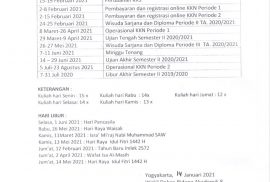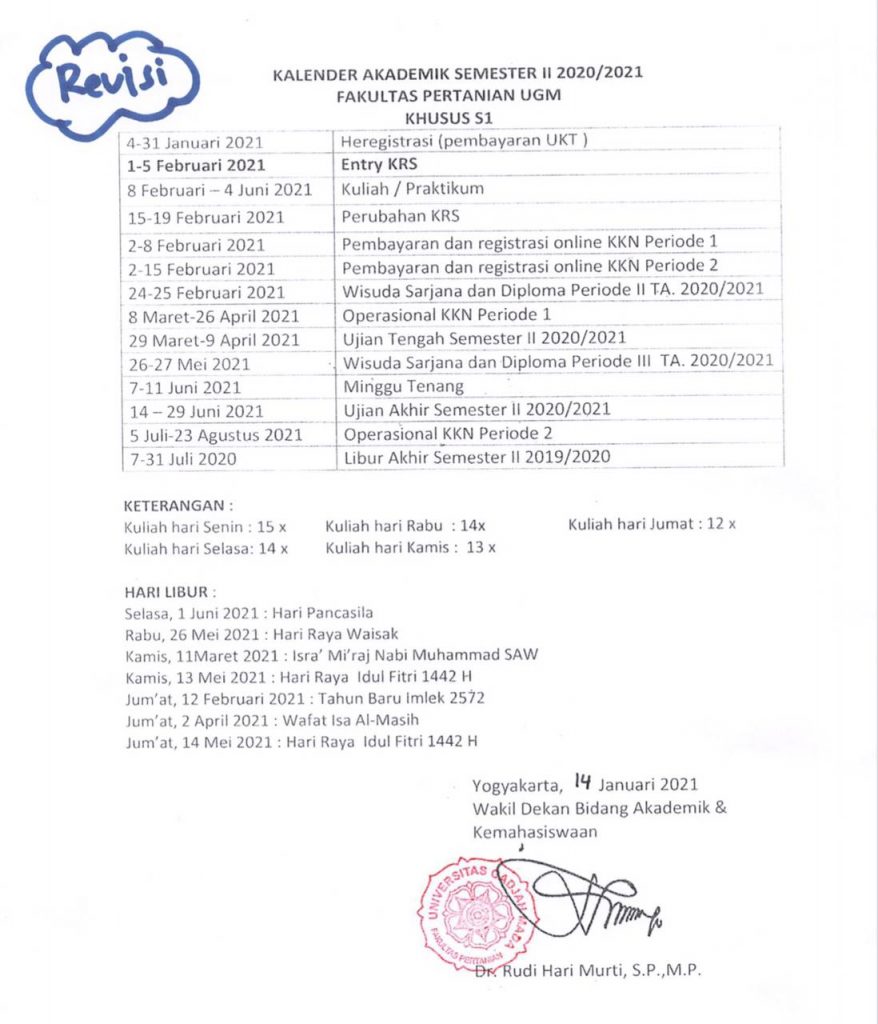2021
Second semester academic year 2020/2021 will soon begin, please be aware for the course input schedule. Input can be done through SIMASTER UGM

Radipta Lailatussifa, Amir Husni, and Alim Isnansetyo
Abstract
This research aims to know antioxidant activity, total phenolic, nutrient, and screening phytochemistry compounds of S. hystrix dry powder. Water extract from the dried sample of brown algae (S. hystrix) was prepared and examined for its phenolic compounds. The amount of total phenolic compounds in water extract was about 11.43 g Gallic Acid Equivalent (GAE)/100 g of dry basis sample, as measured by using Folin-Ciocalteu method. The antioxidant activity (Radical Scavenging Activity/RSA) of BHT as a standard was high about 96% inhibition of radical DPPH with 1 mg dry sample/ml solvent. The IC50 of the BHT was 0.227 ± 0.001 mg of dry sample/ ml solvent. While the radical activity (RSA) of S. hystrix dry powder was about 65.28% at 1 mg dry sample/ml solvent. The IC50 of S. hystrix dry powder was 0.616 ± 0.005 mg of dry sample/ml solvent. Nutrient contents and bioactive compounds of dry powder S. hystrix were balanced to support antioxidant activity of the sample. The results suggest that this alga is a potential source of natural antioxidant.Keywords: Antioxidant activity; Sargassum hystrix dry powder; phytochemistry; the phenolic; compound nutrient contents
Jurnal Perikanan Universitas Gadjah Mada 19 (1): 29-37 Full textTheodora Linggaryati Gotama, Amir Husni, and Ustadi
Abstract
The objective of this research was to determine the potential effects of Sargassum hystrix extracts (SHE) on the glucose levels, lipid profile, and pancreas of streptozotocin (STZ)-induced diabetic rats. SHE at 200, 300, and 400 mg/kg was administered orally to STZ-induced diabetic rats once daily for 15 days. Glucose levels, lipid profile, and weight of rats were measured in the normal state and on the 15th day. The histology of the pancreas was observed on the 15th day. The results showed that the preprandial and postprandial glucose levels in the group treated with SHE at 300 mg/kg were significantly reduced compared with those of the diabetes group. Additionally, the levels of triglycerides and cholesterol in the 300 mg/kg SHE group were significantly different from those in the diabetes group. However, the levels of high-density lipoprotein cholesterol and low-density lipoprotein cholesterol across the treatment groups did not have significant differences. Necrosis was found in all STZ-induced rats. SHE at a dose of 300 mg/kg had the best capability to lower the levels of preprandial and postprandial glucose and to prevent necrosis in diabetic rats.











